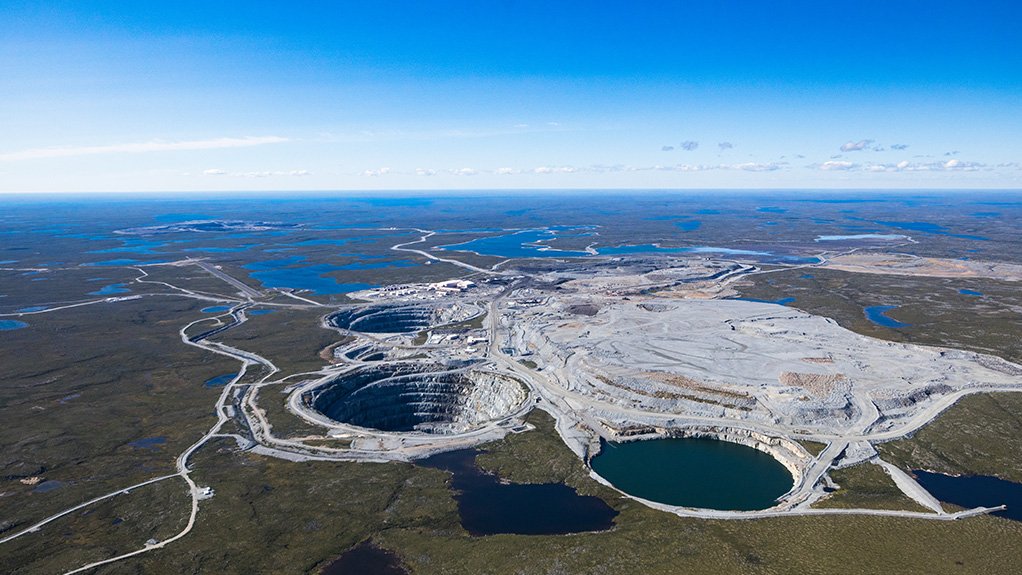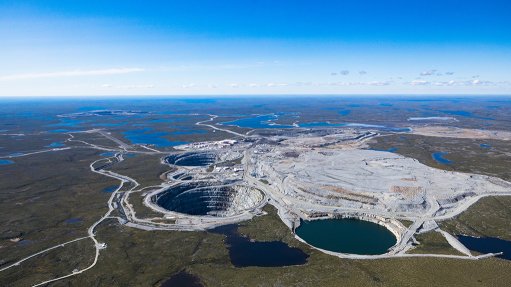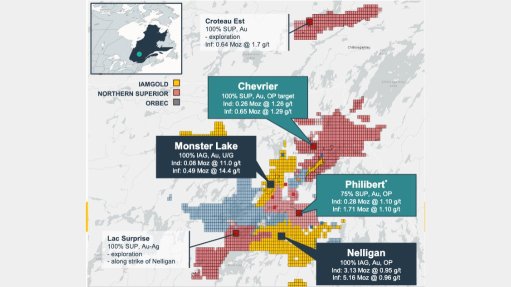Burgundy CEO believes his diamond company is undervalued
ASX-listed Burgundy Diamond Mines (BDM) CEO and MD Kim Truter believes the company is trading at a significant discount, presenting a real opportunity for investors.
“At some point, the market is going to figure out that our share price should actually be four times higher, and so there's going to be a lot of winners in the next period of time as our share price rerates,” he tells Mining Weekly.
Truter believes the company’s fundamentals support this assertion and says it is only a matter of time before the share price is rerated.
“We will emerge as a multibillion-dollar company. That’s where we’re going,” he says.
Last year marked a transformative and foundational year for BDM as it evolved from a modest-sized exploration company into a globally significant diamond producer after acquiring the Ekati diamond mine in Canada’s Northwest Territories.
This acquisition, Truter believes, places BDM among the top-tier publicly listed, end-to-end diamond companies. The company is now the biggest diamond producer in Canada and the Group of Seven nations, and thereby the biggest diamond producer listed on the ASX.
“We have purposely structured the company so that our financial makeup is different to our competitors. We deliberately made sure that BDM does not carry much debt. When we did our capital raising to acquire Ekati, a key focus was to make sure we carry very little debt,” Truter explains.
He adds that the company’s strong balance sheet is important because, in the diamond industry, many companies have been lurching from crisis to crisis.
“We’re making sure that we are a company that doesn't do things that way, rather focusing on being a well-constructed company that can be responsible and consistent, and that can outperform everyone regardless of the pricing cycle,” Truter states.
However, despite the company’s successes and efforts, he says BDM’s trading multiples are still low.
“When you look at our earnings to trading multiples, we are down below two, while our competitors are well above three,” he says. However, he firmly believes this will change soon.
In the fourth quarter of 2023, BDM showed strong financial results, mostly owing to the performance of the newly acquired Ekati asset. Revenue was up 37% year-on-year, from $121-million to $166-million, with a 19% improvement in carat recoveries year-on-year, from one-million carats in the fourth quarter of 2022 to 1.2-million carats at the end of last year.
The company also managed to sell more diamonds, despite many other diamond producers, such as De Beers, stating that their sales figures had dipped.
News outlet Bloomberg said on January 15 that De Beers had cut its prices by between 10% and 15% owing to softened demand – the steepest price cut made in years.
In the face of such market conditions, with some of the world’s biggest diamond producers struggling to make a decent margin, BDM sales somehow went up 41% year-on-year, from 1.3-million carats sold in the fourth quarter of 2022 to 1.8-million carats sold in the fourth quarter of 2023.
BDM said in its 2023 fourth quarter financial report that, despite the market softening in the sales of cut and polished diamonds, and the resulting decline in demand for rough diamonds, Ekati diamonds have continued to generate strong buyer interest and high sell-through rates.
Truter believes De Beers’ struggle with diamond pricing and lacklustre demand is directly a consequence of its diamonds coming from Africa. He says Russian diamonds are also struggling to make a good margin owing to sanctions and political pressure.
“However, Canadian diamonds are selling like hotcakes. I'm not as concerned about some of those pricing things that others are talking about because what we're finding is our Canadian stones are selling fast. We can sell everything we produce and more,” he says.
However, despite the distraction of price fluctuations, Truter says BDM tries to ignore it.
“One of the things that we do with our operating teams is that we actually ask them to ignore price. They need to run the business, generating profit through their own efforts, not relying on price. In that way, we protect ourselves against any downturn in the market. So basically, we achieve our results through our skillset and not through market fluctuation. A good price is just a bonus,” he comments.
He says he expects a modest long-term diamond price growth trajectory of about 3% to 5%, linked to the global consumer price index.
“It's quite logical. If people have disposable income, they will buy luxury goods. If they don't have disposable income, they won't. Over time, you might have spikes and dips, such as just before the pandemic. But I believe that diamond pricing will now start to return to the long-term trend, as opposed to the spikes and dips of late,” Truter says.
EKATI
He says the acquisition of Ekati was key to ensuring BDM’s long-term success.
“The amazing thing about the property itself is just how many kimberlite pipes exist there. On our property alone, there are 125 kimberlites that basically belong to us, with even more on adjacent properties. That's very unique. I can't think of a single property anywhere else in the world where there'd be that many pipes clustered in one location,” Truter boasts.
He says this proliferation of potential gives BDM a variety of options to extend the life of the Ekati asset.
He explains that the first method for extending the life-of-mine is to continue with tried and tested exploitation of surface and underground opportunities using conventional surface and underground mining techniques.
However, in addition to this, Truter says the company has been looking at employing more innovative mining techniques, such as underwater remote mining using an underwater crawler.
Through this method, the underwater crawler will cut the kimberlite pipe, after which it will be sucked up to a barge floating on the water above it. Thereafter, the kimberlite concentrate will be pumped to shore, whereafter it will be sent off to the process plant. This process will require the creation of a small lake over the kimberlite pipe itself.
“The real advantage of underwater remote mining is you have a very small mining footprint, which is limited to the size of the Kimberlite pipe itself, which is typically only about 150 m in diameter.
“There are no big waste dumps and all the other stuff that you’d normally have with a conventional mine. So from an environmental point of view, it's also a game changer because you reduce your footprint by 90%,” Truter points out.
He says that, if this method works, it will enable BDM to develop many of the kimberlite pipes on the property that are not cost effective from a conventional mining perspective.
Article Enquiry
Email Article
Save Article
Feedback
To advertise email advertising@creamermedia.co.za or click here
Announcements
What's On
Subscribe to improve your user experience...
Option 1 (equivalent of R125 a month):
Receive a weekly copy of Creamer Media's Engineering News & Mining Weekly magazine
(print copy for those in South Africa and e-magazine for those outside of South Africa)
Receive daily email newsletters
Access to full search results
Access archive of magazine back copies
Access to Projects in Progress
Access to ONE Research Report of your choice in PDF format
Option 2 (equivalent of R375 a month):
All benefits from Option 1
PLUS
Access to Creamer Media's Research Channel Africa for ALL Research Reports, in PDF format, on various industrial and mining sectors
including Electricity; Water; Energy Transition; Hydrogen; Roads, Rail and Ports; Coal; Gold; Platinum; Battery Metals; etc.
Already a subscriber?
Forgotten your password?
Receive weekly copy of Creamer Media's Engineering News & Mining Weekly magazine (print copy for those in South Africa and e-magazine for those outside of South Africa)
➕
Recieve daily email newsletters
➕
Access to full search results
➕
Access archive of magazine back copies
➕
Access to Projects in Progress
➕
Access to ONE Research Report of your choice in PDF format
RESEARCH CHANNEL AFRICA
R4500 (equivalent of R375 a month)
SUBSCRIBEAll benefits from Option 1
➕
Access to Creamer Media's Research Channel Africa for ALL Research Reports on various industrial and mining sectors, in PDF format, including on:
Electricity
➕
Water
➕
Energy Transition
➕
Hydrogen
➕
Roads, Rail and Ports
➕
Coal
➕
Gold
➕
Platinum
➕
Battery Metals
➕
etc.
Receive all benefits from Option 1 or Option 2 delivered to numerous people at your company
➕
Multiple User names and Passwords for simultaneous log-ins
➕
Intranet integration access to all in your organisation





















